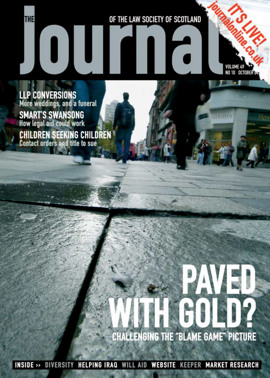Take a deep breath

While news of Boyd Napier’s high profile collapse may have diverted some firms still further from the notion of converting to a limited liability partnership, there are continuing signs that in time LLP will become the conventional model for legal firms.
In fact, the clues to Boyd Napier’s demise can be found in the Journal’s article on this subject in August 2003. While other firms played down the significance of going down the LLP route, for Boyd Napier it represented the keys to a kingdom where they could raise capital and embark on a bold, ambitious and ultimately flawed strategy of acquiring smaller, often rural firms, and invigorating them with the Boyd Napier brand.
For them it was the “new system of corporate governance that was the main attraction”, offering the chance to run the business “like a limited company” rather than a traditional partnership. So although the Boyd Napier scenario was made possible by their being a limited liability partnership, their woes reflect less the dangers of LLP as a business model and more the well known risks in expanding too rapidly based on optimism rather than sound business sense.
In contrast, for the other firms featured then and for firms who have adopted the LLP model since, it is the comparative neutrality of the decision to reconstitute as LLP that has made the decision, if not straightforward, then certainly difficult to argue against.
At Wright Johnston Mackenzie, the question of whether to adopt the new model was on the agenda at their partners’ conference last November. When switched round, the question became “Is there any reason not to become a limited liability partnership?”, and from that position it was hard to justify not being an LLP, explained managing partner Graham Bell.
“The balance of advantages on the whole was quite neutral; yes there was a major logistical aspect of transferring the business into an LLP but that was just hassle.”
Clients keep their cool
The logistics included arranging new banking, transferring PI cover and financial services accreditation, and the thorny issue of informing clients, and whether to gauge their reaction in advance. While in last year’s article, Davidson Chalmers’ Stuart Duncan emphasised the importance of informing clients, Bell suggests that for most of their clients it wasn’t much of an issue. A few posed the question as to whether their PI cover was altering, and on being satisfied it wasn’t, were reassured that they would continue to receive the same standard of service.
Similarly at Brodies, the question of client communication, while important, was more a case of ensuring that clients were under no misapprehension what it was all about. This process involved informing clients that the assets of the old Brodies would be the assets of the LLP and the same lawyers would deliver the same quality of legal advice. Managing partner Bill Drummond admits, however, that if client feedback had indicated any concern about taking the step, they would have “thought long and hard about it”.
Drummond said the firm examined the pros and cons of conversion for nine months, getting feedback across the firm and encouraging an open debate. The result was consensus long before the conversion date.
He too acknowledges that the project management element was the most significant aspect of making the decision to embrace the LLP model, but weighed against individual partners no longer being jointly and severally liable, the inconveniences of conversion were minor.
“It is a major commitment to produce a members’ agreement that will accommodate the new arrangement and fit in with the legislation. It needs a robust agreement to see partners through many years and there was a lot to do in formulating an agreement of that nature for 35 partners or so.
“Then there were issues such as the firm branding, website, taking close supplier relationships and the bank with you, as well as having the Society’s rules to adhere to.
“But people realise that converting is a sensible thing to do: particularly if you don’t have an up to date and current partnership agreement then it is a means of ensuring you have one.”
Bell says it was important in drafting the new agreement to resist the temptation to simply rehash the old agreement and remain as partners who continue to indemnify each other – that would defeat the purpose of LLP.
“We had to come up with a document which recognised the LLP as the primary liable party, indemnifying its members but also ensuring that if members are doing things outwith the normal course of their job they should indemnify the LLP.” Even so, the view at WJM is that individual members will still be named in a writ in any negligence action against an LLP.
“Hassle is worth it”
Drummond recognises it is probably the hassle factor that has deterred some firms, but suggests partnerships should look on it as a catalyst to organise things properly.
“Look at the number of leading City firms that have done it: obviously they feel the hassle is worth it. We operate in a UK environment and my perception is that LLPs are becoming fairly commonplace. The message would be, get on with it if that’s what you want to do. We were perhaps fortunate in that we could call on a corporate partner to take ownership of the documentation and ensure we kept on schedule. Having that resource made our financial year end a realistic target.”
The perceived wisdom is that while the hassle factor may impede some firms from converting, there would be no reason for firms starting out to practise as anything other than an LLP. Bell says he can’t imagine new firms setting up as anything else.
“Other firms will change too when they focus on the issue and pose the question we asked. Yes it is a chore, and in your firm you need a champion, someone to keep the momentum going and put their back into it.”
For firms considering adopting LLP, the WJM timescale saw them make the decision in November and have everything in place for the end of their financial year in March.
The whole process also afforded them the opportunity to examine what they stood for as a firm. In essence the drafting of the new members’ agreement offered the chance to look at things afresh.
So if the case for LLPs is so clear-cut, why have comparatively few firms made the leap? More telling might be an article examining why firms reject or resist LLP. The suspicion lingers that the idea of publishing accounts may explain why some firms who might have been expected to embrace the model have been shy when it comes to converting. The biggest firms’ competitive instincts may leave them reluctant to divulge details to competitor firms.
Bell acknowledges publishing accounts can be a double-edged sword. Clearly if you aren’t doing well it serves to throw sharp focus on a firm’s struggles, but on the other hand if you are doing too well it risks alienating clients who may start to scrutinise their next invoice that little bit more closely.
“We took the view on balance that we were doing well enough to be proud of our figures but not doing so excessively well that we would risk embarrassment if clients examined our accounts. The big firms’ accounts may well attract attention but I don’t think there is much of a story in our figures.”
Drummond has heard the theory of the risk of doing too well as an LLP but says that trade magazines have long given details of firms’ performances. In any event, Brodies have reported to clients about financial performance for the last couple of years albeit not in a statutory accounts format.
For both of the recent converts there is little suggestion that a fringe benefit is either the potential to recapitalise or a reduction in PII.
Finally, there is the vexed issue of what LLP members are called. Are they indeed members or has the old partnership title stuck? Drummond is emphatic that at Brodies they call themselves partners. “It is a limited liability partnership and though it is a members’ agreement we call ourselves partners.”
At WJM they had a period of referring to themselves as members, but after consulting with the Society were assured they could go back to referring to themselves as partners.
“Members is an awkward title to use internally and externally with endless scope for double entendres, and we are glad to go back to having partners’ meetings”, said Bell.
In this issue
- Citizenship, society and solicitors
- The well unfair state
- Litigation nation
- Best medicine
- Take a deep breath
- What title?
- Walk this way?
- Know your strategy
- e-quilibrium?
- The researchers
- Rights out of anarchy
- Political correctness or positive change?
- Steering clear
- How far can a board go?
- Major role for new tribunal
- The race is on (again)
- Planning a superhighway
- Website reviews
- Book reviews
- Single survey's lonely heart
- In harmony
- Clearing the path






